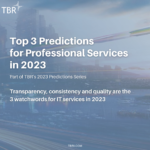Top 3 Predictions for Telecom Going Into 2023 and Beyond
Update: Download your free copy of TBR’s Top Telecom Predictions for 2024 special report, Telecom Industry Retrenches in Response to Macroeconomic Pressures
Telecom industry will face an unprecedented level of uncertainty and risk in 2023
Top 3 predictions for Telecom industry (CSPs) in 2023
- Global telecom industry enters rationalization phase
- CSP investment in 5G infrastructure enters post-peak phase
- Cablecos build out their own cellular networks in the U.S.
CSPs face a confluence of headwinds in 2023
2023 will likely be one of the most uncertain and challenging periods in the telecom industry’s history. A confluence of negative shocks will concurrently impact the industry next year, with telcos and cablecos bearing the brunt of the impact and vendors suffering knock-on effects.
The challenges communication service providers (CSPs) face are large in magnitude, broad in scope and occurring simultaneously. They include the following:
- Rising interest rates: After more than a decade of unprecedented low interest rates — thanks to key central banks’ quantitative easing (QE) strategies, which were originally enacted to combat the global financial crisis of 2008-2009 — CSPs now face rapidly rising interest rates as central banks aggressively pivot to quantitative tightening (QT) to combat inflation. This reversion of interest rates portends challenges for the telecom industry due to record leverage in the sector.
- Inflation: General price increases across the global economy pose a risk to CSPs’ input costs, especially around labor and energy. Average revenue per user (ARPU) is struggling to keep pace and new revenue sources remain elusive, squeezing CSPs’ margins.
- Lack of 5G ROI: Despite spending several hundred billion dollars in aggregate thus far on spectrum and infrastructure for 5G, there remains no clear path to ROI for CSPs, further deteriorating CSPs’ business fundamentals.
- Technological complexity: New technologies and architectures (e.g., open vRAN and network slicing) are proving to be more complex and expensive to deploy than originally anticipated, posing a business risk and hindering CSPs from evolving into digital service providers.
- Energy costs: Supply shortages and rising energy costs pose a risk to the ability to run telecom equipment and are likely to impact CSPs’ margins as energy is one of the largest components of CSPs’ opex.
- Supply chain disruption: Sourcing parts remains a challenge, delaying the timing of infrastructure deployment and fueling inflation. Talent remains in short supply and is expensive, especially for new skills that are required for digital transformation. In addition, the worsening geopolitical environment and continued COVID-19 lockdowns in China threaten to create new and persistent supply chain bottlenecks.
- New competitors: Especially hyperscalers, which are capturing new value created from key enablement technologies, including 5G, multi-access edge computing (MEC) and AI and machine learning (ML), as well as upending the traditional connectivity business model
- Labor strikes: Strikes are likely to occur as unionized labor rallies for wages that keep pace with inflation. Strikes pose a risk to CSP operations and margins; TBR notes this issue mostly impacts CSPs in the U.S. and Europe, where unions in the telecom industry are most prevalent.
- Economic recession: The global slowdown that began in 2H22 (mostly driven by QT) is highly likely to morph into a global recession in 2023, portending adverse demand-side impacts for CSPs and their vendors. Bad debts are likely to increase, and consumers and businesses are likely to optimize the telecom services they purchase.
The impact of these challenges will be partially mitigated by government stimulus (much of which was greenlighted during the COVID-19 pandemic), which continues to directly and indirectly power the global economy (e.g., subsidize capex, support low-income households, backstop consumer and corporate credit markets), though the impact of the economic support is waning.
TBR’s convictions that the telecom industry will look very different by the end of this decade continue to strengthen, with current events laying the groundwork for structural changes in the composition of the telecom industry and the business model for connectivity. Economic gyrations and other challenges have a history of driving significant changes in the market, at a broader scope and much faster pace than what occurs during stable market conditions. The current situation will prove no different.
TBR’s 2023 Predictions is a special series examining market trends and business changes in key markets. Covered segments include cloud & software, devices, digital transformation, IT infrastructure, professional services, federal IT services and telecom.

 Technology Business Research, Inc.
Technology Business Research, Inc. Technology Business Research, Inc.
Technology Business Research, Inc. Technology Business Research, Inc.
Technology Business Research, Inc.